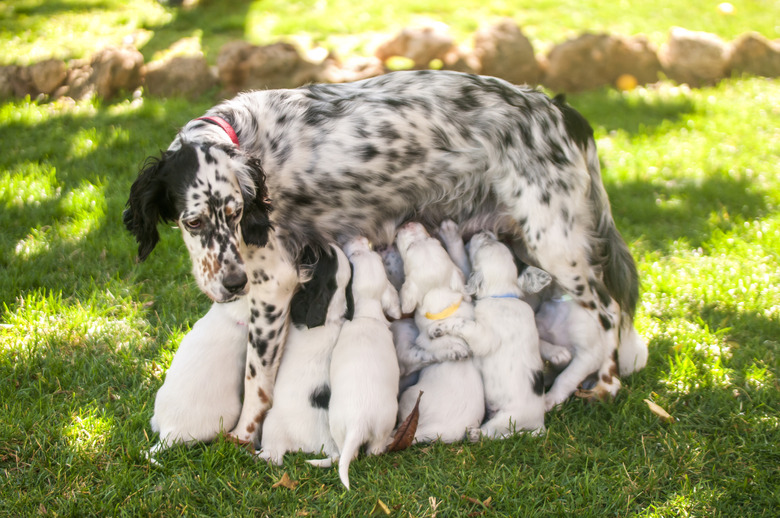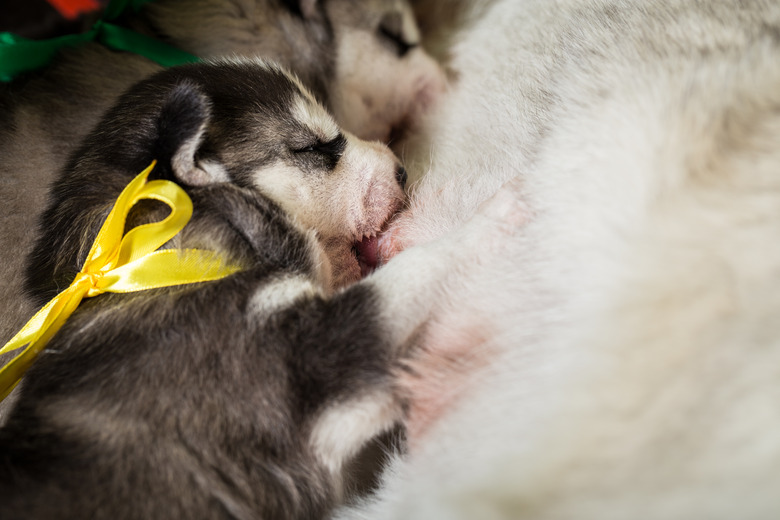How To Tell If My Dog Is Lactating
A dog's reproductive system is designed to lactate only when she needs to produce milk, for a limited time before and after pregnancy. Usually you'll be able to recognize a lactating dog by looking at her before she delivers because her mammary glands will be enlarged, and perhaps leaking a trickle of milk. If you don't see those signs, you can check for yourself after she delivers.
Canine mammary system
Canine mammary system
Even male dogs have a mammary system, but a female dog's is highly developed for the sole purpose of providing nourishment to her puppies. The system is comprised of two rows of mammary glands. Most female dogs have 10 total mammary glands, five on either side of their abdominal midline. The top two rows are the thoracic pair, the two below that are the abdominal pair, and the lowest row is the inguinal pair.
The glands are made of connective and glandular tissue, as well as secretive tissue that's present only while needed, during pregnancy and lactation, until the puppies are weaned. Each gland has a teat, or nipple, which accommodates approximately 7 to 16 ducts and openings to supply milk to a nursing puppy.
The hormones involved in canine lactation
The hormones involved in canine lactation
There are four hormones that stimulate milk production:
- Estrogen alerts the mammary tissue of the pregnancy, starting the production of the cells that will secrete milk.
- Progesterone depends on estrogen and helps maintain milk secretion during lactation.
- Prolactin prepares the mammary glands for milk production and helps maintain production throughout lactation; it also stimulates maternal behavior in the dog.
- Relaxin prepares the cervix, uterus, and vagina for birth and encourages mammary development.
Milk letdown is prompted by oxytocin and prolactin when the puppies stimulate their mother's nipple. Oxytocin causes the mammary gland to tense and force milk into the teats while prolactin prompts milk to be released into reservoir areas.
Predelivery lactation signs in dogs
Predelivery lactation signs in dogs
In the final two or three weeks before your dog delivers you will notice her mammary glands enlarge as they fill with milk. Her nipples will grow larger and darker and you may notice a milky discharge leak.
When a dog begins labor, a puppy will press against her cervix, stimulating prolactin and milk production. As the puppies nurse and suck on their mother's nipples, her milk will begin to flow. In fact, as soon as the first puppy is born it can begin nursing, even as the mother continues her labor with the rest of the litter.
How to tell if a mother dog is producing milk
How to tell if a mother dog is producing milk
Can you milk a dog? Actually, yes, and it's a helpful tool to see if your dog is producing healthy milk. To ensure your dog is lactating, gently press or draw down on a nipple to produce milk. The mammary glands should feel supple, warm, and soft. Hard or hot nipples may indicate mastitis. The puppies' behavior also provides clues about whether the mother is lactating. They should be nursing quietly. If they are cold or crying, they may not be getting enough milk or the mother may have mastitis.
Lactation complications in dogs
Lactation complications in dogs
If a mother dog is not producing milk for her puppies it can be due to several potential complications including:
- Mastitis, an inflammation or infection of the mammary glands, usually caused by a bacterial infection. Signs include swelling of the affected gland, heat, pain and abnormal milk, such as a greenish hue or tinged with blood.
- Agalactica, insufficient or lack of milk production. If a dog isn't producing enough milk, it could be as simple as a change up of diet or increasing their caloric intake.
- Galactostasis in dogs is a collection of unexcreted milk in the mammary gland, resulting in swelling and inflammation.
Any sign that a dog is not lactating normally requires veterinary attention, for the mother and puppies' health.

